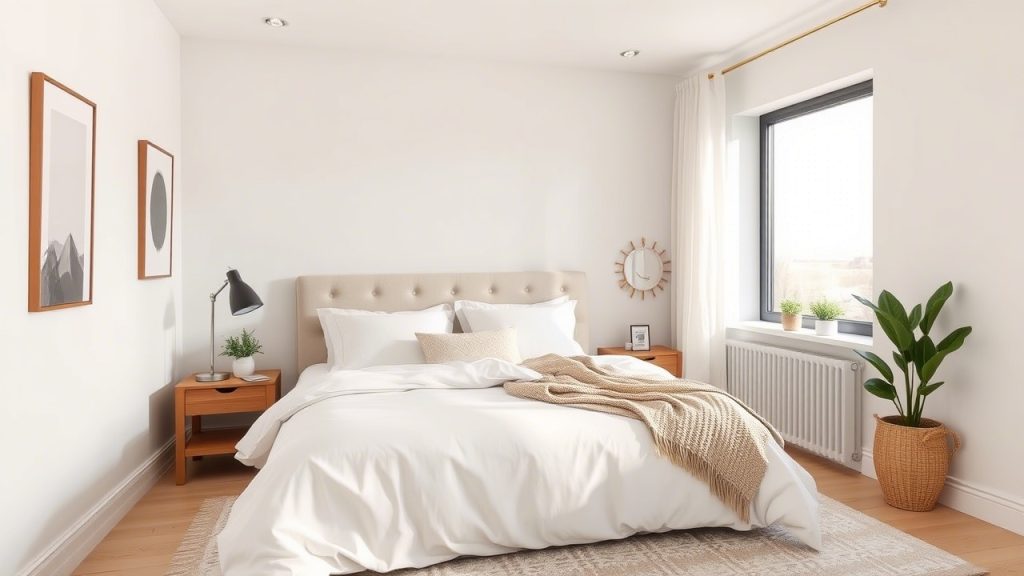How to Arrange Your Bedroom for Maximum Comfort
Your bedroom is more than just a place to sleep; it’s a sanctuary, a personal retreat where you can relax, rejuvenate, and escape the stresses of the outside world. Arranging your bedroom for maximum comfort is essential to creating a space that promotes restful sleep, relaxation, and overall well-being. Whether you’re looking to upgrade your bedroom to enhance your quality of sleep or simply want to create a more inviting and functional environment, there are several key factors to consider.
We’ll walk you through the steps and design principles to arrange your bedroom for optimal comfort. From furniture placement and color schemes to lighting choices and storage solutions, we’ll cover everything you need to know to make your bedroom a restful haven.
1. Prioritize the Bed: The Focal Point of the Room
The most important piece of furniture in any bedroom is, of course, the bed. It serves as the focal point of the room and should be arranged in a way that maximizes comfort. When positioning your bed, consider the following tips:
Placement of the Bed
The ideal placement for a bed is typically against the longest wall in the room. This allows you to maximize space and ensures that the bed is the main focal point. Avoid placing your bed directly under a window, as this can lead to drafts or an uncomfortable sleeping environment. If possible, position the bed so that you have a clear view of the door without being directly in line with it (this is often referred to as the “command position” in feng shui). This positioning provides a sense of security and control over the space.
Bed Size and Mattress Comfort
Choose a bed size that suits your room and your needs. If you have a small bedroom, a queen-sized bed may be more appropriate, whereas a larger room may accommodate a king-sized bed comfortably. Mattress comfort is crucial for quality sleep, so invest in a high-quality mattress that provides adequate support and comfort for your body type and sleep position.
Bedding and Pillows
Soft, breathable bedding is key to maximizing comfort. Opt for natural fabrics like cotton, linen, or bamboo for sheets, as they promote airflow and help regulate body temperature. A cozy duvet or comforter adds an extra layer of warmth during colder months. Don’t forget to invest in a variety of pillows that suit your sleeping style—firm for back sleepers, soft for side sleepers, and a mix for versatility.
2. Lighting: Create a Relaxing Atmosphere
Lighting plays a crucial role in creating a bedroom environment that is both soothing and functional. The right lighting can help set the mood, whether you’re winding down for bed or getting ready for the day. Here’s how to optimize your lighting:
Ambient Lighting
Ambient lighting is the general lighting in the room and is essential for creating a soft, inviting atmosphere. Soft overhead lights, such as a chandelier, pendant lights, or dimmable ceiling lights, are ideal. If your bedroom doesn’t have a ceiling fixture, consider using floor lamps or wall sconces for ambient light.
Task Lighting
Task lighting is essential for activities like reading, dressing, or working in your bedroom. Bedside lamps with adjustable brightness are perfect for reading in bed without straining your eyes. If you need a place to work or do your makeup, consider a well-lit vanity or desk area.
Accent Lighting
To enhance the cozy, relaxing atmosphere of your bedroom, use accent lighting. This can include string lights, LED strips, or candles to add warmth and visual interest. Accent lighting creates a soft, inviting glow, perfect for winding down at night.
Natural Light
Natural light plays a significant role in how a room feels. A well-lit bedroom with plenty of natural light can make the space feel more open and airy. If privacy is a concern, consider sheer curtains that allow light to filter through while still offering some protection from the outside world.
3. Choose Soothing Colors
Color has a powerful effect on our mood and well-being. In the bedroom, it’s important to choose colors that promote relaxation and tranquility. Here are some color suggestions that can help create a calming atmosphere:
Soft Neutrals
Neutral shades such as soft whites, creams, taupes, and light grays are ideal for a calming bedroom. These colors create a serene backdrop and allow other elements in the room to stand out.
Cool Tones
Cool tones like blues, greens, and lavenders are known for their calming effects. Soft blues can help lower stress levels, while greens evoke a sense of nature and relaxation. Lavender is a great option for creating a peaceful environment and promoting sleep.
Warm Tones
While cool tones are typically more relaxing, some people find that warm tones like soft beiges, light yellows, or pale peach add a sense of comfort and coziness to the room. These colors can make the space feel inviting and intimate.
When selecting your bedroom color palette, try to limit the number of colors to create a cohesive look. You can always introduce additional pops of color through accessories like throw pillows, rugs, or artwork.
4. Maximize Storage and Organization
A clutter-free bedroom is essential for both comfort and mental well-being. Too much clutter can lead to feelings of stress and unease, while an organized space helps promote relaxation and peace of mind. Here are a few strategies to maximize storage and organization in your bedroom:
Under-Bed Storage
Use the space under your bed for storage. Invest in under-bed bins or drawers to keep extra blankets, shoes, or seasonal clothing out of sight. This will free up valuable floor space and help keep your bedroom tidy.
Smart Furniture Choices
Choose furniture that serves multiple purposes. For example, a storage ottoman can double as extra seating and a place to store blankets or books. A nightstand with drawers provides a convenient place to store essentials like your phone, books, and personal items.
Closet Organization
Organizing your closet efficiently can make a huge difference in the overall appearance of your bedroom. Use closet organizers, shelving units, or bins to keep clothes and accessories neatly stored. A well-organized closet means less clutter in the rest of the room.
Minimalism
Try to keep only the essentials in your bedroom. Avoid overfilling the room with unnecessary decor or furniture. A minimalist approach will create a clean, peaceful environment that’s conducive to rest and relaxation.
5. Incorporate Nature and Personal Touches
Bringing natural elements into your bedroom can enhance the overall ambiance and contribute to a more comfortable environment. Plants, natural textures, and personalized decor add warmth to the space. They also bring personality and create a cozy atmosphere.
Plants
Plants are known to have a calming effect. Not only can they improve air quality in your bedroom, but they also make the environment more pleasant. Choose low-maintenance indoor plants like succulents, snake plants, or peace lilies to add greenery without requiring too much attention.
Natural Materials
Incorporating natural materials like wood, bamboo, or rattan in your furniture and decor can add a sense of warmth and grounding to the room. Wood-framed mirrors, bamboo blinds, and wicker baskets are great options for adding texture and visual interest.
Personal Touches
Add personal touches that make the room feel uniquely yours. This could include family photos, meaningful artwork, or a cozy throw blanket that reflects your style. Personalization will make your bedroom feel more inviting and comforting.
6. Maintain Proper Temperature and Ventilation
Comfort in the bedroom is not just about how the space looks, but also how it feels. Temperature and air quality can significantly impact your ability to rest and sleep soundly. Here are a few tips to optimize your bedroom environment:
Temperature Control
The ideal bedroom temperature for sleep is generally between 60-67°F (15-20°C). Make sure your bedroom has proper heating or cooling to maintain a comfortable temperature throughout the year. A ceiling fan can also help with air circulation, particularly in warmer months.
Air Quality
Good air quality is essential for a restful sleep experience. Ensure your bedroom is well-ventilated, and consider investing in an air purifier to filter out dust, allergens, and pollutants. Opening a window for fresh air during the day can also improve air circulation.
Frequently Asked Questions
1. What is the best way to arrange a small bedroom for maximum comfort?
For a small bedroom, focus on optimizing space and functionality. Place the bed against the longest wall to maximize floor space, and use multifunctional furniture like a storage ottoman or a bed with built-in drawers. Choose light colors to make the room feel larger and keep decor minimal to reduce clutter.
2. How can I make my bedroom feel more cozy?
To make your bedroom feel cozier, use soft lighting, warm colors, and plush bedding. Add comfortable textiles like throw pillows, blankets, and area rugs to create a sense of warmth. Incorporate natural elements like plants or wooden furniture to add texture and make the room feel inviting.
3. What is the best lighting for a relaxing bedroom?
Soft, warm lighting is ideal for a relaxing bedroom. Use dimmable ceiling lights, bedside lamps, and accent lighting like candles or string lights to create a calming atmosphere. Avoid harsh overhead lights and opt for gentle, soothing light sources.
4. How can I improve the air quality in my bedroom?
Improve air quality by ensuring proper ventilation, using an air purifier, and keeping windows open during the day to allow fresh air in. Adding indoor plants can also help purify the air and contribute to a healthier sleep environment.
5. Should I have a TV in my bedroom for maximum comfort?
While having a TV in the bedroom is a personal preference, it may not be ideal for creating a peaceful sleep environment. The blue light emitted by screens can interfere with your ability to fall asleep. If you do have a TV, consider limiting screen time before bed and keeping the TV out of sight when not in use.
6. How can I organize my bedroom to reduce clutter?
To reduce clutter, focus on maximizing storage with furniture that offers hidden compartments. Use under-bed storage bins, closet organizers, and multifunctional furniture to keep things tidy. Regularly declutter by getting rid of items you no longer need.
7. What are the best colors for a restful bedroom?
Soft neutrals like whites, creams, and grays are great for creating a serene environment. Cool tones like blue, green, and lavender are also ideal for promoting relaxation and sleep. Choose colors that resonate with your personal style and create a calming ambiance.
8. How important is mattress quality for a comfortable bedroom?
The quality of your mattress plays a significant role in your overall comfort and sleep quality. Choose a mattress that suits your sleeping style and provides the right level of support for your body. A high-quality mattress can improve your sleep and contribute to better overall health.
9. How can I incorporate feng shui into my bedroom layout?
In feng shui, the bed should be placed in the “command position” where you can see the door without being directly in line with it. Keep the space around the bed clear to promote positive energy flow and avoid placing mirrors in a way that reflects the bed. Choose calming colors and incorporate natural elements like wood and plants for balance.
Conclusion
Arranging your bedroom for maximum comfort involves more than just picking out furniture and decor—it’s about creating an environment that promotes rest, relaxation, and overall well-being. By prioritizing comfort in your bed, lighting, colors, storage, and temperature, you can transform your bedroom into a sanctuary that helps you unwind and sleep better. With a little planning and attention to detail, your bedroom can become the peaceful retreat you’ve always dreamed of.





